Build Your Own Self Watering Containers
This post may contain affiliate links, which means that I may receive a commission if you make a purchase using these links. As an Amazon Associate I earn from qualifying purchases.
Many versions of self watering containers, also known as self watering grow boxes, self watering pots, and self watering planters are sold online, but you can make them yourself for a fraction of the cost out of some easy to find items.

This post on constructing self watering containers out of 18-gallon storage totes was originally written in May 2009 and continues to be popular. I updated the photos, copy, and added additional information.
I still use the original self watering containers each year. I have early blight in my garden soil that often reduces the health and production of my tomato plants. Growing tomatoes in self watering planters allows the plants to grow early blight free for the whole season. Celery also grows very well in self watering pots because they receive a steady moisture level. I have also grown peppers, melons, eggplant, cucumber, and summer squash in self watering containers with great success.
What are Self Watering Containers?
Self watering containers are an enclosed growing system that decreases moisture evaporation and offers a consistent water supply to your plants. It is made up of two chambers, the growing chamber and the water reservoir chamber. The growing chamber contains a wick that descends into the water reservoir that pulls water up into the growing chamber as needed for the plants.
Many versions of self watering containers are sold online. For example, this Self-Watering Planter is almost the same size as an 18 gallon tote. You can make your own self watering container for a fraction of the cost out of some easy to find items.
What are the Benefits of Self Watering Containers?
- Flexible Growing Space: Self watering containers are perfect for container gardens because they can be located anywhere in your yard, on your balcony, or along the edge of your driveway. Place the containers on wheels and you can move them more easily to different locations to take advantage of maximum sun exposure.
- A Consistent Supply of Water: Your plants will have water available to them when they need it and will not suffer from extreme moisture fluctuations that often range between soaking wet and bone dry.
- Provides Moisture to the Roots: When you fill a self watering container, water is stored at the bottom in a separate chamber. Moisture is wicked up into the soil directly to the roots of the plants as needed. In comparison, when you water a traditional container, you add it to the soil surface. If the water doesn’t penetrate deeply enough into the pot, your plants will develop a shallow root system that may stunt growth.
- No Nutrition Loss: Since self watering containers are an enclosed system, nutrients do not get washed away when deep watering like conventional containers.
- Pest and Disease Free: Beginning with fresh growing medium ensures that your plants can become established before pests and disease make their appearance.
- No Weeding: Plastic mulch covers the soil surface preventing weeds seeds from blowing in and sprouting.
How to Build Your Own Self Watering Containers
Materials:
1 18-gallon storage tote with lid (see notes below)
3-4 inch wide container for wicking basket
2 coffee cans to support aeration shelf (see notes below)
24-inch pipe for fill tube, one end slanted
Landscape fabric
1 black plastic garbage bag
Zip ties
1 2 cu ft. bag of organic potting mix (about 52 quarts)
Organic fertilizer
Tools:
Drill with assorted drill bits
Heavy scissors or saw to cut cover
Saw to cut pipe
Marking Pen
Procedure:
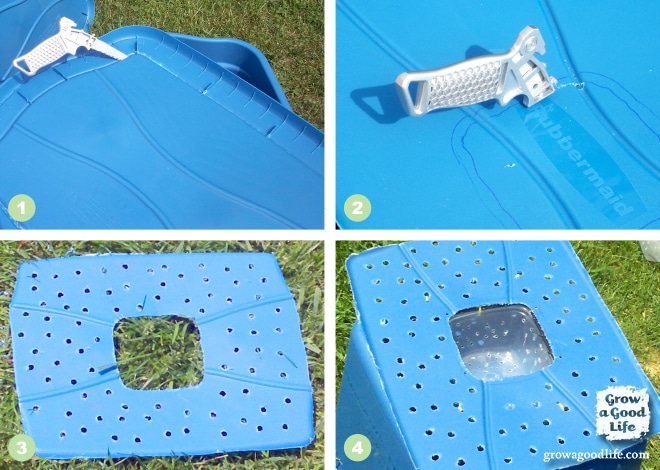
1. Remove the center of the lid. Carefully cut out the center of the lid to be used as the aeration shelf between the soil and the water chamber. Leave about two inches around the lid, so it can be used to hold the plastic mulch to the top of the container later.
2. Cut an opening for the wicking basket. Place your wicking basket at the center of the aeration shelf and trace the edges with your marking pen. Cut the opening slightly smaller (about 1/4-inch) than the outline.
3. Drill holes in the aeration shelf. Drill holes about 1-inch apart for air exchange.
4. Attach Wicking Basket to the aeration shelf. Drill holes a bunch of holes in the wicking basket to allow water to soak through. Drill holes around the edges and attach to the aeration shelf with zip ties.

5. Check the fit. Assemble your shelf supports and aeration shelf inside the tote to check the fit. The shelf should fit snug against the tote with no buckling. Trim the shelf if needed.
6. Drill a 1⁄4-inch overfill hole about 1⁄2-inch below the aeration shelf. Water will come out the overfill hole when the container is full. The hole also allows air circulations between the aeration shelf and the water.
7. Cut an opening for the fill tube. Position fill tube, trace an outline, and cut out the hole for the tube.
8. Add landscape fabric. Trim a piece of landscape fabric to cover the aeration shelf. Try to leave a 2-inch overlap. Cut holes for the fill tube and the wicking chamber. The landscape fabric prevents the soil from dropping down into the water reservoir.
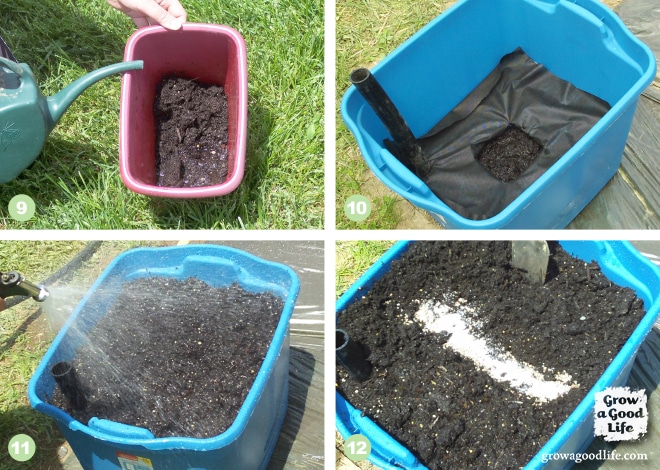
9. Add wet soil to wicking basket. Mix potting soil and water in a container until it is saturated. Pack into the wicking basket.
10. Move container to its final location. Place your self-watering container in its permanent location because it will be too heavy to move after adding the potting mix. Be sure the fill tube is easily reachable to fill with a hose.
11. Fill container with potting mix. Add the rest of the potting mix to the self watering container 3-inches at a time saturating each layer with water until the container is full. This is important, as dry potting mix will not wick water.
12. Add fertilizer. Dig a trench in the soil across the middle of the self watering planter and add 2-cups of fertilizer along the trench. Cover the fertilizer strip with potting mix and water in. Do not mix the fertilizer into the potting mix or spread it around.
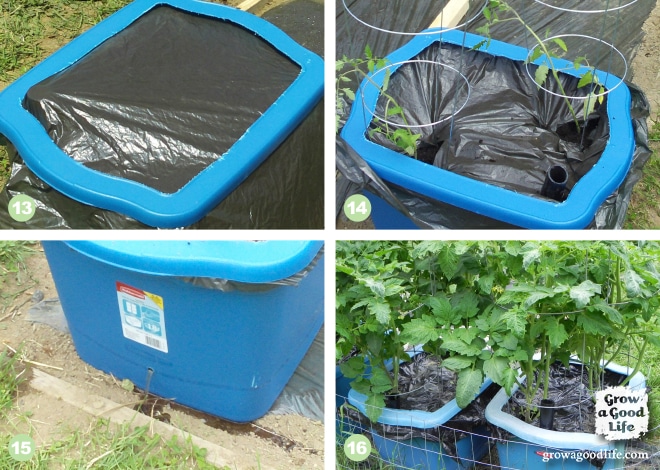
13. Layer plastic mulch. Lay the plastic garbage bag over the filled self watering container and snap on the cover. Cut a hole for the fill tube. The garbage bag will serve as a plastic mulch and help hold moisture in.
14. Plant. Avoiding the fertilizer strip, cut holes in the mulch and add your transplants. I plant two determinant or bush tomato plants in each 18-gallon self watering container, so I cut an X into the solar mulch where the tomatoes will be planted in opposite corners of the self-watering container.
15. Fill water reservoir compartment. Water through the fill tube until water comes out the overfill hole. Add plant supports if necessary. Keep water reservoir full or the wicking action will cease. Top off every day in the heat of summer.
16. Watch your plants grow and enjoy the harvest.
Additional Tips:
- Choose a Good Quality Tote: The Rubbermaid Roughneck and the Sterilite Ultra totes are more flexible and hold up to manipulation without cracking. I found these lovely blue ones on clearance for $5 and these are still being used years later. Simply drain water and store in a shed for winter. You should be able to find these totes at your local big box stores for under $10.
- Aeration Shelf Support: Be sure that whatever you use to hold up the aeration shelf is sturdy enough to support the weight of the potting mix when wet. I use recycled 30 oz. ground coffee containers cut in half to provide a stable shelf.
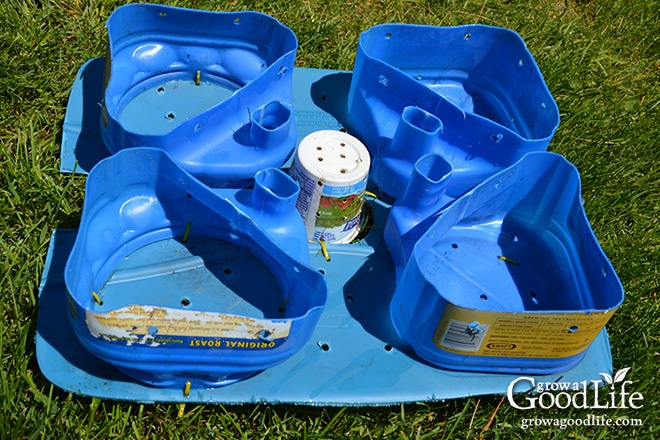
- Wicking Chamber: The wicking chamber container doesn’t need to be very large. I’ve used recycled food storage containers and 8 oz. yogurt containers.
- Potting Mix: Select a good quality, lightweight potting mix suitable for containers or mix your own at the ratio of 45% peat moss, 45% compost, 10% perlite, plus 2 cups of hydrated lime or dolomite. About 2 cubic feet is needed to fill one 18-gallon self watering container.
- Organic Fertilizer: I use Epsoma Plant-tone for growing vegetables and Tomato-Tone for tomatoes.
- Replanting: Reusing self watering planters is easy. Just remove the old plants and old fertilizer strip. Give the soil a deep soaking, replace fertilizer strip, fill reservoir chamber, and replant.
You May Also Like:
- 10 Steps to Starting Seedlings Indoors
- How to Grow Celery from Seed
- How to Harden Off Transplants
- Seasoned Tomato Sauce Recipe for Canning
Good planning is key to a successful vegetable garden
Whether you are new to growing your own food or have been growing a vegetable garden for years, you will benefit from some planning each year. You will find everything you need to organize and plan your vegetable garden in my PDF eBook, Grow a Good Life Guide to Planning Your Vegetable Garden.
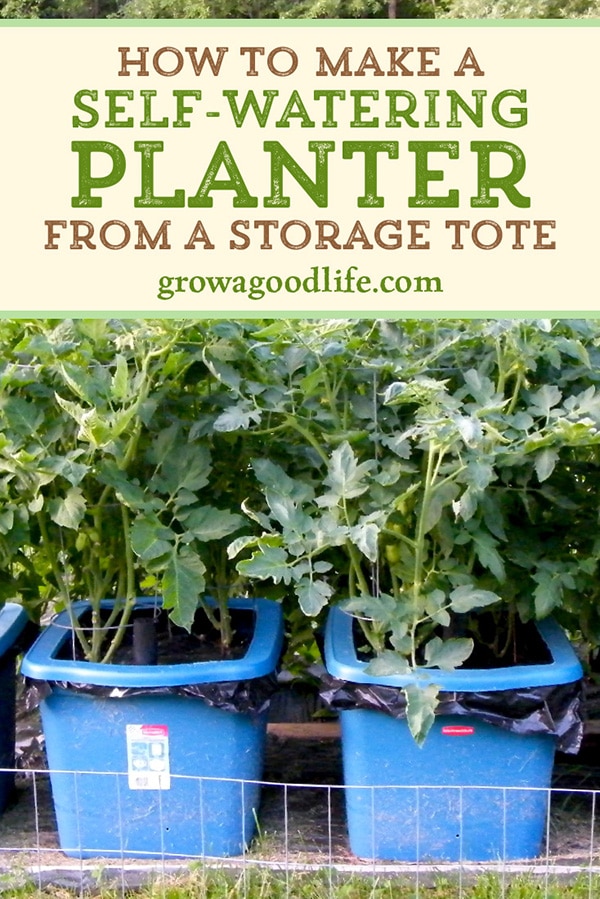


Don’t the wicking container and the aeration shelf supports need to be about the same depth to make maximal use of the water in the reservoir? Seems like I need to find supports and containers that “match”, but perhaps I am missing something.
Paul, Yes, it would be beneficial if the supports and wicking basket were the same height for better wicking capability. However, as long as the wicking basket is in water, it will draw up moisture even if it is a little short. The yogurt container I used as a wicking basket is shorter than the recycled coffee cans cut in half and it works ok.
For the shelf supports, how many inches high? Or in other words, how many inches high should the water reservoir be?
Kevin, Mine ended up about 3-inches high. It doesn’t have to be exact.
Does the landscape fabric serve as the wick in this self watering container?
Karen, The container filled with soil in the center is the wick. It is called the wicking basket in the instructions. The landscape fabric prevents the soil from dropping down into the water reservoir.
Thanks for reposting this great idea! My second and third grade students are growing plants for science and are always super disappointed when they outgrow the plastic cups and die. We literally have all the supplies sitting around the school looking like garbage. I needed the specific materials and instructions to follow as it’s been a while since I first saw this idea. Hopefully, we will have peas to eat before the end of the school year – for once!
Bibi, Thank you for your comment and for also showing your students the reward of growing food. I am keeping my fingers crossed that there will be plenty of peas for everyone to taste.
Thank you for this very informative post. This is my first year planting vegetables so I’m still learning. Because of the gopher problems in my yard, I elected to grow the veggies in containers and thanks to your post I plan on using your method next year.
I live in Northern California where summer temperatures can sometimes reach 100 degrees and higher for a number of days in a row. Do you see any danger to the roots if I use the plastic mulch or should I remove it on hot days? I like the idea of an enclosed system.
Ingrid, You do want to keep some sort of mulch on top to keep the soil cool and prevent the moisture from evaporating. You could use another type of mulch instead of plastic. A thick layer of wood chips would be a good option.
Please can you use clay hollow bricks to support the aeration shelf?
Stella, Yes, clay bricks would be a great support for the aeration shelf.
How do you fertilizer with the plastic covering? Also will it make the soil too hot or scorch my plants?
Marisa, You only add fertilizer once before covering. Please see step 12. The plastic mulch shouldn’t scorch your plants. If you are uncomfortable using the plastic, go ahead and mulch with straw or wood chips. You do want something on the surface to hold in moisture and prevent it from evaporating from the soil.
I’m almost done assembling my first of two self watering tubs. I have a question about the wicking bucket. Do you not line it with landscape fabric as well so the dirt doesn’t get into the water supply?
Michelle, I don’t line the wicking basket and yes, some soil will fall through, but not much. I wouldn’t worry about it.
ABout how many celery seedlings do you plant into the 18 gallon size? wanting to avoid the fertlier strip and proper spacing. LOVE this idea. Amazing and easy!!!
Hi Jill! I plant 4 celery plants in an 18 gallon self watering container. The fertilizer strip is in the middle, and I plant the celery to all four corners.
Hi! Do you remove the soil and add new each year or do you just add new soil on top? I want to use this for as long as possible once I have it set up. Maybe even moving it inside in the winter. I want to start it now to get my veggies going early (the temp is still dropping too low here in Western PA for outside veggies) then moving it outside to the back porch once it stays warm enough. Thank you, Rebecca
Rebecca, I love the idea of starting the plants early and moving the containers outside when it gets warmer. The containers are really heavy though. If you let the containers dry out a bit before moving, it should be easier.
If you grow different crops each season in your self-watering containers, you shouldn’t have to worry about the soil. Simply remove the old plants and old fertilizer strip, give the soil a deep soaking, replace fertilizer strip, fill reservoir chamber, and replant the following year. If you find the soil has broken down and reduced in volume, add more to the top before adding your fertilizer.
I do recycle the soil every 3-years or so because I use my self-watering containers to grow tomatoes and want to avoid soil born diseases. I dump out the used soil mix into the garden and replace with fresh. But if you rotate your crops every season, you shouldn’t have a problem with disease or pests building up.
Learn more about crop rotation here.